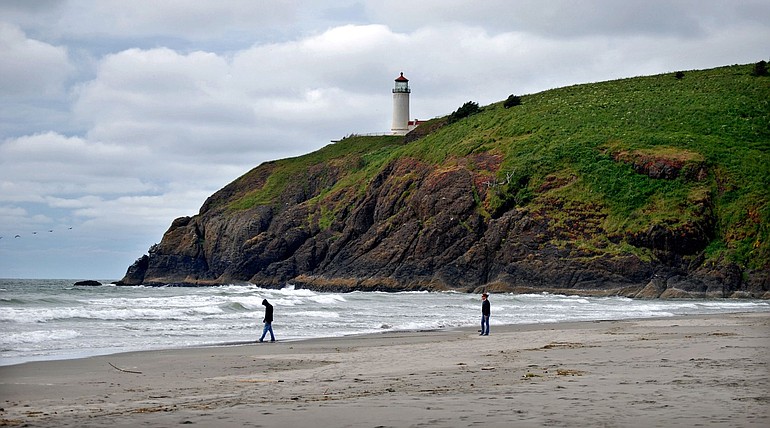So, you think Mount St. Helens was a big deal?
In the scope of geological history in the Pacific Northwest, the 1980 eruption hardly registers as a hiccup, at least compared to the massive lava flows that formed the Columbia River basin we know today.
New research suggests the volcanic birth of the Columbia plateau occurred much faster than previously believed. Massive flows of lava that define the Columbia River basin may have emerged quickly enough to roil the planet’s climate and drive some plants and animals to extinction, according to a new study published in the science journal Lithos by researchers at Washington State University and Britain’s Open University.
“These are basalt flows that covered huge areas of the Pacific Northwest,” said Steve Reidel, a researcher at WSU Tri-Cities who co-authored the new study. “It covered 200,000 square kilometers. Portland and Vancouver sit on the lava flows down there. They made it all the way down to Portland and out to the coast.”
The Columbia basin forms the world’s youngest continental flood basalt province, but it’s ancient by today’s standards.
Scientists have long known that thick sheets of molten basalt emerged from present-day Eastern Washington, Oregon and Idaho, mainly between 17 million and 14 million years ago. It now appears that about two-thirds of that material, known as Grande Ronde deposits, emerged in less than half a million years.
While that seems like a long time, it greatly compresses the 2 million-year time frame previously assumed for the bulk of the Grand Ronde flows.
So much lava in such a relatively short period of time would have been likely to jettison immense clouds of volcanic gases such as sulfur, water vapor and carbon dioxide. These massive flows — enough to weigh down the continental crust beneath it — not only changed the landscape in the Pacific Northwest, but the airborne emissions could have altered the climate worldwide.
“You’re taking any inconvenience caused by Mount St. Helens or the present eruption in Iceland and multiplying it by many, many orders of magnitude,” Reidel said.
British researchers, writing last year in the science journal Geology, suggest the eruptions could have cooled temperatures by as much as 2 degrees Celsius by generating a sustained source of sun-blocking clouds and ash carried by jet streams across the planet. Yet, at the same time, hot air rising from the lava would have sucked moist marine air across what were then relatively dinky Cascade mountains and turned the arid east side into monsoon country.
“This was probably like a rain forest like nobody’s ever seen before,” said Reidel, who teaches at WSU’s campus in the Tri-Cities.
It started with a “hot spot” where a plume of superheated magma rises under the Earth’s crust.
The hot spot now situated under Yellowstone National Park once generated huge volumes of Hawaiian-style lava from fissures as long as 100 miles in present-day Eastern Oregon, Washington and Idaho. As Reidel describes it, the hot spot formed a stem feeding magma from the planet’s mantle up against the brittle base of the earth’s crust. There, it mushroomed out and spread northward as it emerged on the surface. (The hot spot remains in place under present-day Wyoming but the North American continent has drifted southwest.)
Pushing west over the course of months or years, one flow piled atop another until great globs of hot lava rolled off the edge of the continent to form black basalt headlands such as Cape Disappointment.
The sheer mass was enough to weigh down the earth’s crust. The thickest deposits are 3½ miles deep below Tri-Cities, which nonetheless sits only a few hundred feet above sea level.
Researchers figure the duration of each eruptive period lasted months to years, interspersed by a few thousand years of dormancy in between. Any single pulse of lava would have generated 10,000 times as much material as the eruption that obliterated the top of Mount St. Helens nearly 30 years ago on May 18, 1980.
Previously, scientists thought the flows occurred across a time frame as wide as 2 million years.
Researchers used precise equipment to compare the rate of decay between argon isotopes in the oldest and youngest of the Grande Ronde deposits. The difference amounted to as little as 240,000 years — or as long as 420,000 years at the outside of the margin of error.
“That’s pretty significant, in that it tells us a lot of lava’s coming out in a very, very short period of time,” Reidel said.
He hopes the research points the way for paleontologists to re-examine the planet’s fossil record.
“We can start wondering whether there were extinctions,” he said.
Richard Waitt, a geologist with the U.S. Geological Survey in Vancouver, said better dating may help to explain changes in the planet’s climate at the time. By dating elevated levels of carbon deposits in ocean cores, scientists might be able to ascertain whether they correspond to the now relatively tight time frame of Columbia basin flood basalts.
“Anything alive at that time in North America would have been greatly impacted,” Reidel said. “Ash would have blown to the east. Undoubtably, it would have been a major stress. The question is whether it was enough to spark an extinction.”
Erik Robinson: 360-735-4551, or erik.robinson@columbian.com.



